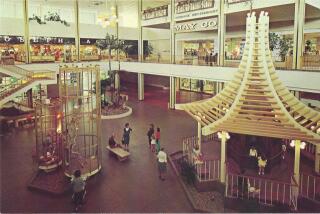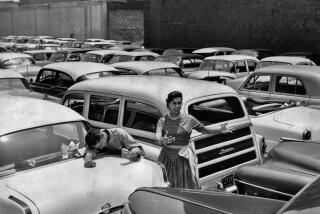George Nelson, Urban Designer, Creator of Storagewall Modules
- Share via
George Nelson, considered one of the most talented industrial and urban designers of his time, died Wednesdayin New York City of unannounced causes.
The designer of the 1943 “Grass on Main Street” concept that became the postwar urban shopping mall was 77 and at his death may have been known best for the Storagewall, the adaptable storage systems featuring wall-to-wall and floor-to-ceiling modules that are in wide use today.
Trained as an architect, he became a visionary who took to heart Herbert Hoover’s 1932 warning that “if you elect that Bolshevik (Franklin D. Roosevelt) President, grass will grow on Times Square.”
In a 1982 interview with the Los Angeles Times, Nelson recalled that “I was not very political, but I was so enchanted by the (mental) picture that I voted for Roosevelt.”
Malls and Playgrounds
The vision lingered with him more than a decade, and in 1943 he helped create a series of advertisements beneath the headline: “Your Children Could Romp Here While You Shop.”
The ads were illustrated with renderings of enclosed shopping malls, surrounded by verdant playgrounds with swings and sandboxes for children. Also involved were pictures of shrub-surrounded benches on which parents sat, watching their contented children at play as they rested between visits to nearby shops and restaurants.
The campaign was credited with creating an interest in the “shopping villages” that sprang up across the country in the 1950s.
Nelson also supplied the mass production methods that made possible the inexpensive design furniture of the postwar era, once adapting a Navy technique of spraying self-webbing plastic on “mothballed” ships to make bubble lamps. With the Herman Miller Co. of New York, he designed desks, tables, chairs, clocks and lamps, many of which now are collectors items.
‘Kitchen Debate’ Milieu
In 1959 he designed the American National Exhibition in Moscow at which Richard M. Nixon and Nikita S. Khrushchev staged their acrimonious “kitchen debate.”
Nelson was educated at the Yale School of Fine Arts and the American Academy in Rome and opened his first New York office in 1946. Earlier he had been a managing editor of Architectural Forum, a magazine he helped found.
Over the years he became a respected design and architecture critic, writing for magazines and extolling the benefits of giving workers a say in the control of office environments in his several books. He encouraged simplicity and function both in home and industrial design, saying that what works best is “relating everything to everything.”
Among his most recent honors was his appointment as scholar in residence at the Smithsonian Institution National Museum of Design in New York City, where he continued to rail against the “sterile office panels” he increasingly found everywhere and the “technological barbarians” who put them there.
More to Read
The biggest entertainment stories
Get our big stories about Hollywood, film, television, music, arts, culture and more right in your inbox as soon as they publish.
You may occasionally receive promotional content from the Los Angeles Times.










